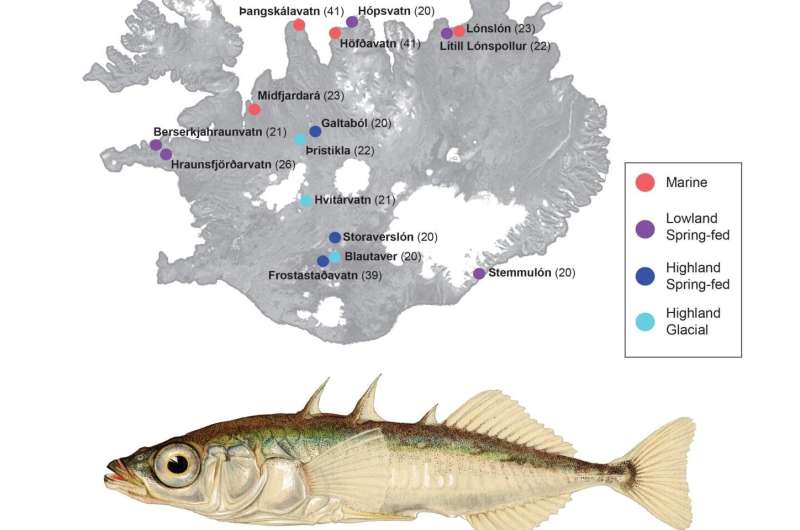Novel study of small fish in Icelandic waters sheds new light on adaptive change

Innovative research showing that populations of a small fish that live in both Iceland's lakes and marine waters, respond more quickly and differently to predators after they invade new freshwater lakes, demonstrating how some animals can adapt rapidly to changes in their environments and may be able to adapt to climate change.
The study of threespined sticklebacks, spearheaded by a Penn State wildlife behavioral ecologist, involved the development of a robotic trout predator, the introduction of the scent of arctic char preying on sticklebacks, and painstaking measurements of sticklebacks' reaction time to both those visual and olfactory predator cues. The laboratory experiments included fish that were collected in saltwater estuaries along the Icelandic coast and from both crystal clear spring-fed lakes and lakes clouded by the runoff from melting glaciers.
The researchers focused on the threespine stickleback fish because it is considered an evolutionary model due to the exceptional capacity of marine populations to repeatedly invade freshwater habitats across the Northern Hemisphere, according to Jason Keagy, assistant research professor of wildlife behavioral ecology in the College of Agricultural Sciences, who led an international team in the study.
"Those incursions from the ocean into lakes have caused well-documented adaptation in physiology, morphology, life history and behavior of the fish," he said. "Iceland provides a unique opportunity to study rapid adaptation to novel environments because of a large network of geologically young—maximum 14,000 years old to a minimum of just 50 years old—lakes spread across multiple watersheds, providing natural replication."
In laboratory trials, the researchers experimentally measured anti-predatory responses of wild-caught sticklebacks from marine, lowland spring-fed, highland spring-fed and highland glacial lakes, sequentially exposing fish to both olfactory and mechano-visual predator cues. All populations were tested in two light conditions, simulating the visual properties of typical spring-fed and glacial lakes, as measured via spectrophotometry, and thus representing both their native and a new visual environment.

Comparing reactions between light treatments allowed the researchers to gauge the level of "plasticity" in anti-predatory behavior of fish from different habitat types, depending on immediate visual conditions. Plasticity is the flexibility of an organism to deal with changes in its environment or differences between its various habitats.
"The design of our study allowed us to make inferences on evolutionary changes in behavior by comparing the magnitude and direction of change between marine fish—which represent the ancestral state—and highland freshwater fish, expected to be most genetically distant from marine fish," Keagy said.
To determine how colonizing newly formed glacial lakes with turbidity-induced low-visibility conditions affects anti-predator behavior in Icelandic threespine sticklebacks, the researchers tested nearly 400 fish from 15 populations and four habitat types. Those fish were assessed for their reaction to two predator cues—mechano-visual (by exposing them to a robotic trout predator) versus olfactory (by exposing them to the scent of arctic char preying on sticklebacks)—in high- versus low-visibility light treatments.
Fish reacted differently to the cues and were affected by lighting environment, confirming that both have important effects on predator detection and evasion. In findings recently published in the Proceedings of the Royal Society B: Biological Sciences, the researchers reported that fish from spring-fed lakes—especially from the highlands where they likely were more diverged from marine fish than lowland fish—reacted fastest to mechano-visual cues and were generally most active. Highland glacial fish showed strong responses to olfactory cues and the greatest plasticity in response to light levels.
This study illustrates rapid evolutionary changes in anti-predator behavior that makes the fish better able to survive in the new habitats they have invaded, Keagy explained. The results also suggest an additional role for behavioral plasticity, enabling populations to persist in the face of frequent changes in environmental conditions, as likely occurs in glacial lakes.
That capability represents a hopeful sign for some wildlife populations confronting quickly changing conditions triggered by a warming climate, Keagy suggested. "Knowing that the sticklebacks have this resiliency guides us to what we might look for in other wildlife populations," he said. "I think this points to two forces working together—one is evolution and genetic variation, but there isn't a lot of time for that right now—and plasticity, the natural ability of populations to respond."
More information: Murielle Ålund et al, Sensory environment affects Icelandic threespine stickleback's anti-predator escape behaviour, Proceedings of the Royal Society B: Biological Sciences (2022). DOI: 10.1098/rspb.2022.0044
Journal information: Proceedings of the Royal Society B
Provided by Pennsylvania State University



















